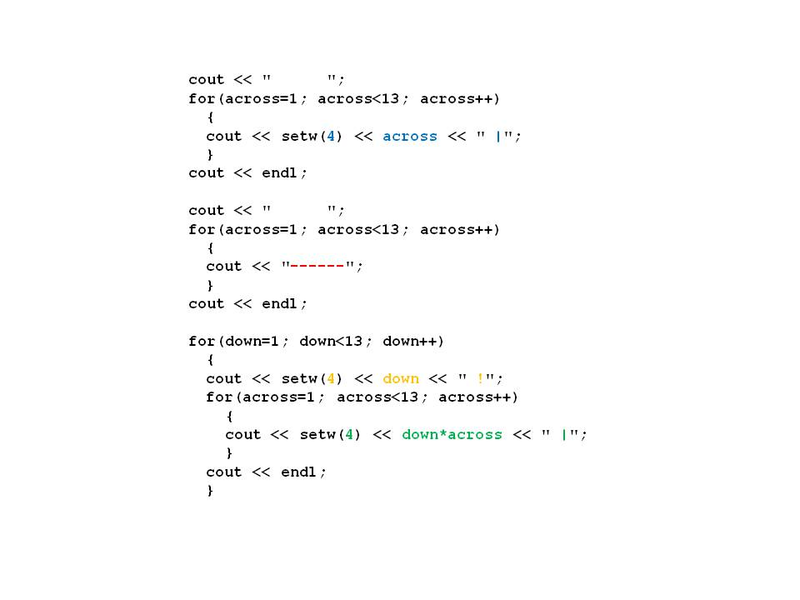Here is an example of a 12 by 12 multiplication table:
|
1 |
2 |
3 |
4 |
5 |
6 |
7 |
8 |
9 |
10 |
11 |
12 |
|
|
1! |
1 |
2 |
3 |
4 |
5 |
6 |
7 |
8 |
9 |
10 |
11 |
12 |
|
2! |
2 |
4 |
6 |
8 |
10 |
12 |
14 |
16 |
18 |
20 |
22 |
24 |
|
3! |
3 |
6 |
9 |
12 |
15 |
18 |
21 |
24 |
27 |
30 |
33 |
36 |
|
4! |
4 |
8 |
12 |
16 |
20 |
24 |
28 |
32 |
36 |
40 |
44 |
48 |
|
5! |
5 |
10 |
15 |
20 |
25 |
30 |
35 |
40 |
45 |
50 |
55 |
60 |
|
7! |
7 |
14 |
21 |
28 |
35 |
42 |
49 |
56 |
63 |
70 |
77 |
84 |
|
8! |
8 |
16 |
24 |
32 |
40 |
48 |
56 |
64 |
72 |
80 |
88 |
95 |
|
9! |
9 |
18 |
27 |
36 |
54 |
63 |
72 |
81 |
90 |
99 |
108 |
117 |
|
10! |
10 |
20 |
30 |
40 |
50 |
60 |
70 |
80 |
90 |
100 |
110 |
120 |
|
11! |
11 |
22 |
33 |
44 |
55 |
66 |
77 |
88 |
99 |
110 |
121 |
132 |
|
12! |
12 |
24 |
36 |
48 |
60 |
72 |
84 |
96 |
108 |
120 |
132 |
144 |
We might also see that the answers could be designed as a collection of cells (each cell being exactly six spaces wide). The C++ source code to produce the above is:
Example 15.5: C++ source code: nested for loops -multiplication table
cout << " ";for(across=1; across <13; across++) { cout << setw(4) << across << " |"; }cout << endl;
cout << " ";for(across=1; across <13; across++) { cout << "------"; }cout << endl;
for(down=1; down <13; down++) { cout << setw(4) << down << " !"; for(across=1; across <13; across++) { cout << setw(4) << down*across << " |"; } cout << endl; }


- 2412 reads






